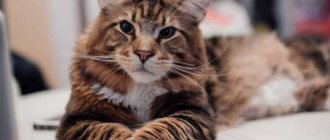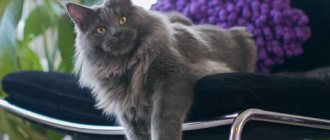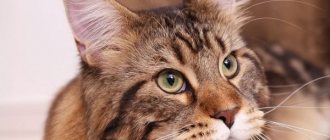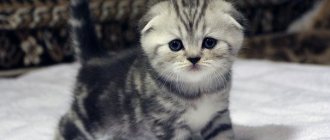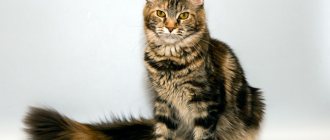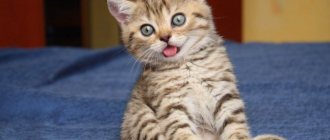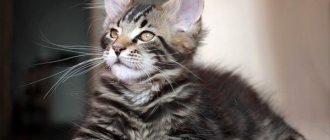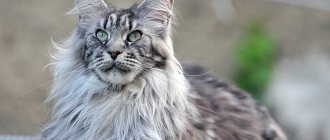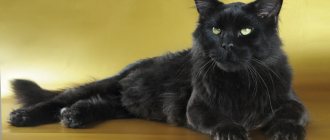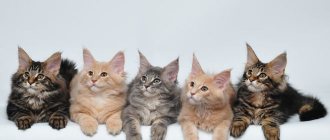The decision to acquire a purebred pet is always a lottery for lovers. To protect yourself from the tricks of scammers, you need to know how to distinguish a Maine Coon kitten from an ordinary Vaska. Familiarizing yourself with the distinctive characteristics of a descendant of American raccoons before a significant meeting will make the task much easier and ensure a good choice.
Maine Coon real in natural habitat
Characteristic signs
The brightest representatives of this breed have a very specific appearance, which differs from the appearance of yard and mongrel cats.
It’s quite easy to distinguish a Maine Coon kitten from an ordinary one/Yandex Collections
The main signs that distinguish a Maine Coon from an ordinary cat:
- Americans are famous for their large, triangular ears that point upward, rather than forward, as with ordinary cats. There is also a small tassel at the tip - the main distinguishing feature of the breed.
- Elongated head shape with large and high cheekbones. When viewed from the front, the head appears square-shaped.
- Purebred representatives of the breed have fox eyes, almond-shaped. They are characterized by slanting, and not roundness, like other cats.
- The animal boasts dense and voluminous fur of medium length. As for color, there are two genetic colors: red, black, all other colors are considered shades.
- The breed is distinguished by its strong and wiry build. As well as a heavy skeleton and a wide chest. Another feature of the pet is its very long tail, it is almost twice as long as the others.
One way to distinguish a Maine Coon cat is to find out its age.
Kittens are large in size; a five-week-old pet has the same weight as an ordinary outbred cat that is six months old.
Briefly about the breed
The name "Maine Coon" comes from the American state of Maine, often pronounced as "main", "main", where the breed originated. And “coon” is a derivative of the English word “raccoon”, because the raccoon coloration is often found on the cat’s tail. Hence the name “Maine raccoon cat”.
The Maine Coon breed has another name: “North American semi-longhair cat,” since many felinologists believe that coons are native to the northeast of North America. Local cats with short hair, according to one version, were crossed with imported long-haired animals (possibly Persians and Angoras).
In the harsh conditions of North America, only the hardiest and strongest survived. The habitat shaped the modern appearance of the Maine cat, which has retained many features even during selection:
- Sharp, powerful fangs, which in modern coons sometimes protrude from under the upper lip, are a necessary weapon against rats and for competition with other carnivores.
- Long mustaches are an excellent adaptation for movement at night, when relying on sight alone is dangerous.
- A long fluffy tail protected cats from freezing in winter. Coons could spend the night outside with their tail wrapped around their body.
- The lush undercoat provided warmth in the harsh winter, and the guard hair repelled moisture.
- The tufts of fur on the legs not only protected from the cold, but also made the paws wider and therefore more stable, allowing them to move through deep snow. And the gait on furry paws is more silent.
Maine cats quickly became popular. But interest in the breed faded at the beginning of the 20th century. Maine Coons have been eclipsed by Persians. Only since the 70s. In the 20th century, popularity returned. Selection work was divided into 2 directions: the formation of the European (extreme) type of Maine Coon and the traditional American one.
How to distinguish a Maine Coon kitten from a regular one
Pedigree newborns have practically no differences from ordinary kittens. Primary signs appear only when pets reach three months of age.
It is during this period that tufts begin to form on the animal’s ears. If nothing has happened by this time, then there is a possibility that the owners were given a fake.
Distinctive tassels on the ears of Maine Coons/Yandex Collections
Another way to identify a Maine Coon kitten is to look at its body type. Purebred representatives of the breed have a fast-growing skeleton, so the offspring often look awkward.
Their body is thin and awkward, their legs are long, but this is not a sign of illness, but a developmental feature. Soon they will gain the necessary kilograms.
The Maine Coon also has differences in weight at the time of birth, namely:
- ordinary kitten - from 60 to 80 g;
- purebred baby - from 160 to 180 g.
It is worth taking a closer look at the animal itself; it should have a slightly elongated head, the body is covered with dense wool.
There is also fluff between the fingers. Simple cats, on the contrary, have a rounded head shape and smooth and short hair on their bodies.
They don't like loneliness
Maine Coons always strive for the room where there is a person; without attention, they suffer greatly. They, as a rule, choose one owner and remain devoted to him for life. If your cat chose you out of all the family members, then you are very lucky, but there are disadvantages: he is unlikely to give you privacy in the toilet or shower. The doors in the room you are in should always be open. These animals generally hate loneliness: even if you leave the house for just a couple of hours, the Maine Coon will greet you with violent screams. But cats of this breed are easy to teach dog tricks. Our pet always comes when called and knows how to fetch. Some owners even boast that they taught their pet the “sit” command. It’s better for you to always be close, otherwise they may be offended by you and will never let you caress them again. Therefore, either take it with you always or don’t start it at all.
Differences from mestizo
There is a ban on crossing Maine Coons with any other members of the cat family.
Although the law does not stop many breeders from breeding, therefore there are many hybrids, and such animals are much cheaper.
People involved in breeding Maine Coons do not recommend handling kittens.
You can spot a fake even in nurseries, since it is almost impossible to distinguish a Maine Coon from a mixed breed based on external data.
When choosing “Americans” you need to pay attention to the following nuances:
- cost - mestizos cost much less than their purebred counterparts;
- weight and size – mixed-breed cats and American Maine Coons have differences in body weight, the former weigh less.
Most often, Maine Coons are confused with the Siberian cat, which also belongs to the aboriginal breeds. Both representatives feel great in the wild, due to which they have an external similarity.
Cat or cat?
To begin with, of course, you need to decide - is it a cat or is it a cat?
In fact, most often people choose a cat and there is an explanation for this. Firstly, they grow larger than cats. Secondly, cats have a softer character. This does not mean that cats are angry and aggressive, it’s just that cats are calmer and after three to four years they prefer to lazily lie on the sofa as a beautiful decoration.
Cats, on the other hand, are active, playful and need physical activity throughout their entire lives. When choosing the sex of an animal, you should take into account what you want to get - a beautiful couch potato or an active toy.
In addition, according to some beliefs, cats take energy, and cats, on the contrary, heal. Here, of course, it is difficult to refute or, conversely, to assert, since these are just beliefs without any evidence. Although, if a person is superstitious, perhaps this argument will play a decisive role in choosing the sex of the furry.
Choosing a mixed-breed cat
Every cat is unique. But experts believe that by external signs - the shape of the skull, body structure, color and length of fur - it is possible to predict the character traits of a pet from a very young age. And even a predisposition to disease. Mixed breeds of elite cats inherit from their parents the appearance and behavior pattern characteristic of a particular breed. When choosing a mestizo, you should pay attention to the main phenotypes. Try to determine from them what character the cat will have and its future health problems.
"Marquise" phenotype
Short, black fur with white spots. The body constitution of cats is dense, while that of cats is thin. This phenotype is characteristic of short-haired European breeds. These pets have a stable, predictable character. They demonstrate their desires quite clearly. They try to manage the house and achieve their goal with affection or perseverance. They have good health. With poor nutrition, urolithiasis can develop.
Phenotype "Siberian cat"
The color is gray-striped. The coat is long with a thick undercoat. The body is loose or dense. The head is large, round, with a protruding muzzle. Confident, independent character. These animals are “on their own.” They skillfully put the owners in the desired place and show who is boss in the house. Affections are accepted solely of one's own free will.
They don't like it when they are bothered with attention. May experience digestive problems
Suffer from obesity, diabetes, urolithiasis,
Angora cat phenotype
Long or semi-long light coat. Dry, tender body. Elegant, light head. Having an independent disposition, they show miracles of devotion and trust in the owner. Sensing the weakness of the owner, they can show “savagery” and aggressiveness, defending themselves and protecting the territory. They need daily human contact. The owner is expected to be predictable and stable. Health is good. Problems with respiratory function and infections are possible.
"British" phenotype
The coat is dense and short. The head is round, large, with erect ears. The body structure is rough and dense. Tabby and blue-gray color. The tail is thick, with transverse stripes. Independent character. Showing displeasure, they can be stubborn and aggressive. These cats are not easy to handle. Touching is allowed, guided solely by one’s own mood. They often become “masters of masters.” Like all cats with a rough constitution, they have a tendency to chronic kidney diseases and obesity. And also, endocrine system disorders and chronic pancreatitis.
Phenotype "Persian cat"
The coat is long, silky, without coarse guard hairs. The head is round, the nose is flattened. The body constitution is rough or loose. They have an independent character and position themselves as a decoration for the home. They can be capricious and demanding. Persians and mestizos are often cut like a lion. Since long hair needs to be combed, and Persians do not like this procedure. Predisposed to diseases of the genitourinary system and upper respiratory tract.
Phenotype "oriental cat"
A cat with short, delicate fur. Thin, dense skeleton with developed muscles. The body is elongated. Quite heavy with an elegant appearance. Light, graceful head. Large or medium movable ears. The color is varied: spotted, solid, striped, color-point, tabby and others. Due to their focus on the owner and the need for constant communication, they are called “cat-dogs”. Orientals have irrepressible energy. Need active games. If energy is not used, obesity may begin. They strive to restore order in the house. Health is quite good. They may have digestive problems and infections.
Phenotype "Thai cat"
Semi-long or short coat of characteristic colors: blue point, seal point, lilac tabby point, lilac point. The head is round. Eye color is blue. Strong, graceful cats with a dense, but not coarse constitution. The character is even, non-conflicting. The behavior model is close to that of a dog. They need constant contact with the owner. They are acutely aware of his mood swings. Empathizing with the problems of the owners, they can get sick. They are very persistent in achieving their goals. They achieve their goals not through arrogance and aggression, but through persistence and affection. Health is quite good, but they are susceptible to urolithiasis and slow infections.
Taking into account the external signs of the pet, it is possible to predict the future character and behavioral model. Take measures for proper education and prevent possible diseases.
Kitten development
The weight of Maine Coon cats depends not only on the genetic reserve, but also on how responsibly the owner of the animal treats nutrition. Height and weight vary at different stages of a kitten's development, but should always be consistent with each other.
Cats are immediately born large, and the greater the weight of the newborn, the larger the adult cat grows. Surely, you are concerned about the answer to what age Maine Coons grow. Fluffy cats actively increase in size until about a year old, then such a sharp pace decreases, but development continues until 3-4 years.
The growth stages of cats can be divided into 4 periods:
- The neonatal period of life lasts 4 days.
- In the first month it is a sucker.
- Then transitional, when the cub tries adult food. About three weeks pass, while the babies, adapting to new food, reduce their indicators of physical development.
- And after the post-suction period, at this time the kittens finally switch to independent feeding.
The structural features of the body, large muzzle and long hair of furry giants make them seem much more massive than they actually are.
Maintenance and care
Artificial ways to grow, enlarge, make tassels more voluminous:
- Correction of the amount of hair on the upper tip of the ear;
- Periodic thinning, coinciding with molting;
- Gentle hair treatment with medicinal ointments and oils.
Timely, regular examination of the cat, necessary vaccinations, provision of a vitamin complex to maintain immunity, protection from parasites and infections are the key to good health of the pet and, accordingly, lush, beautiful hair tails. Combing the fur every 1-2 days prevents the formation of lumps and reduces the amount of hair eaten by the cat when licking. Knowledgeable breeders recommend bathing Maine Coons once a month or as needed. The process is turned into a fun game, rewarding the animal with tasty treats for good behavior.
Features of behavior
People involved in breeding this breed do not recommend picking up kittens by hand, since it will be difficult for them to distinguish a Maine Coon from an ordinary cat. But those who have already encountered “Americans” know that pets have characteristic habits; they are active, affectionate, friendly and incredibly loyal to their owners.
Those who decide to get a purebred animal should pay attention to their character, since you can distinguish a Maine Coon precisely by its behavior:
- a representative of the breed is very demanding about space, he prefers to have his own corner, the cat is unlikely to sleep anywhere;
- Maine Coon recognizes only one owner in the house, he will not listen to other family members;
- the pet is very patient and friendly towards children, it will never bite or scratch children;
- cats are particularly clean;
- The “American” loves active games, he can play around and show tricks, so you won’t be bored with him.
It is important, even when choosing a cat, to pay attention to the documents. The seller of the animal must provide buyers with papers confirming its pedigree. This data is available only for purebred representatives; all others are issued a veterinary passport. This is the easiest way to distinguish a Maine Coon from other cats.
The documentation describes the merits of the animal, as well as its membership in one of the groups, there are only three of them. Here's a quick look at each class:
- Show – considered the highest level in the group, it includes pets that are intended for exhibitions and participation in breeding;
- Breed - this class consists of cats that exhibit good genetic characteristics; they are mainly used in breeding activities;
- Pet – this category includes purebred kittens that are intended for home keeping. That is, the owners’ plans do not include participation in exhibition events or breeding offspring for the purpose of their subsequent sale.
Pedigree kittens are quite expensive, and there are many cases of fraud associated with the sale. Actually, that’s why you shouldn’t trust just anyone; it’s better to entrust this matter to a professional felinologist. Only a specialist in the breed knows how to distinguish a Maine Coon from a mestizo; photos and physical characteristics of the pet are unlikely to help you choose a purebred kitten.
Source
Factors influencing growth
Factors that influence the growth and development of the Maine Coon can be divided into two types - internal and external. Internal ones include:
- The growth rate of a kitten depends on the breed and its purebred. The higher your birth weight, the more you will gain weight in the future.
- Gender of the kitten. Boys grow faster and gain weight.
- Genetic predisposition. With a high degree of probability, parents of large sizes will have kittens of corresponding sizes.
- The combination of mom and dad's genotypes creates the kitten's own genotype. This is a unique organism that can have its own individuality.
- Hormones. The use of medications can affect the animal's body weight.
There are also external factors that have a significant impact on weight gain and growth of the Maine Coon. These factors include the hygiene of the animal and the conditions in which it lives. The attitude of the mother cat towards him greatly influences the growth of a kitten; sometimes a cat may deprive one of its cubs of attention and care. A newborn kitten should gain 10 grams in weight. in a day.
Where do they come from?
It is worth noting that modern veterinarians, dog handlers and felinologists are against non-professional matings between breeds and representatives without documents and permission to breed. This happens not because these specialists are sorry that new species will appear, but because there are more than 60 varieties of cats.
The work of felinology to improve these breeds continues to this day.
But it also happens that mixed-breed kittens appear in a family where they are not familiar with the methods and conditions of breeding. This often happens if animals of different sexes are in the same room during estrus. Or the owners let the animals go out for a walk during the mating season, which ends in the cat becoming pregnant from an unknown cat.
We suggest you familiarize yourself with: Breeds of chickens colored broiler chickens
Of course, such situations are an example of irresponsible animal keeping, since they pose a threat to both the pet’s life and its health.
Mixed breeds are also produced by owners who decide to independently experiment with matings between breeds
Mixed breeds are also obtained from owners who decided to independently experiment with matings between breeds, which, in their opinion, produce unusual and beautiful crosses and offspring.
Types of colors and their descriptions
Based on the basic colors of Maine Coons, breeders have developed many new colors of the breed. The most valuable of them are single-color variations and covers with a clearly defined pattern or spots.
Tabby
Tabby is a color with stripes. There are additional features:
- The presence of stripes of medium thickness on the muzzle, which outline the eyes and appear in the letter “M” on the cat’s forehead.
- Each hair itself is striped. Light and dark alternate with each other along the entire length. This phenomenon is called "agouti".
The Maine Coon tabby color exists in several subspecies:
- classic;
- brindle;
- ticked;
- spotted
Regardless of the type of tabby pattern, it can be anything that the breed allows. But agouti ranges from light blue to bright red.
Solid
Solid is a monochromatic color. It appeared due to the suppression by breeders of the gene that is responsible for the appearance of the pattern on the coat of a cat of this breed. Respectable Maine Coons do not have obvious stripes or tan marks. But this does not mean that the cat is not a carrier of a recessive gene. Therefore, monochromatic parents may well have tabby-colored kittens.
Solid color comes in the following options:
- black;
- blue;
- red;
- white;
- cream.
A Maine Coon with a black solid color is quite a rare occurrence. Black solid kittens may have subtle stripes, but as they grow, they are completely hidden behind the monochrome.
Solid Blue Maine Coons have no visible stripes and have a beautiful gray coat. Blue Maine Coons often have piercing green eyes.
The red Maine Coon is also somewhat of a rarity. Red shades are typical for most cats, but it is quite difficult to hide the presence of stripes with such pigmentation. Therefore, finding a monochrome ginger cat is quite difficult. Solid light and cream Maine Coons are even rarer.
Tortoiseshell
Tortoiseshell color means that the cat's coat has one predominant color, which is decorated with spots of a contrasting shade. They are located throughout the body in a chaotic manner.
Tortoiseshell colors come in:
- Sitseva. On the fur, markings in the form of patches of basic colors prevail, sometimes white ones are also found, then the color is called “tortoiseshell with white”.
- Pictured. The spots contain a pattern in the form of stripes or stains.
- Scaly. Red and black markings alternate like scales.
- Solid. The spots of basic shades are large in area and stand out with clear boundaries.
Smoky (silver) color
All smoky Maine Coons are united by the obligatory presence of a black or blue “collar”, the tips of the hair of which are painted white.
Depending on the color intensity, the following subspecies of smoky colored cats are distinguished:
- chinchilla (only the tips of the hairs are colored);
- shaded smoke (hairs are colored exactly a quarter);
- black smoke or blue smoke (white color is only at the base of the hair);
- true smoke (hairs are exactly half colored);
- silver (the hair is white at the base and silver at the tip);
- cream (kittens of this breed are born with brilliant white fur, but become cream as they grow older).
Color with white spots
Maine Coon with white spots is another result of the efforts of breeders. This color appeared because many people thought the coloring was spectacular, and the previously missing white markings were considered a defect in the breed.
The main thing for a color with white spots is the clarity of the boundaries. Color variations do not depend on the intensity of the color, but on the number and method of distribution of specks:
- “gloves” (only the bottom of the paws is white);
- van (white color predominates, but the head and tail remain colored);
- “medallion” (white mark on the chest);
- “buttons” (one or more randomly located spots);
- bicolor (white markings are combined with another color in a 1:1 ratio);
- harlequin (a white cat with several large colored markings);
- “tuxedo” (“gloves” and “medallion” are combined with a dark color on the back).
Body structure with dimensions
The Maine Coon body standards describe the body as follows:
- rectangular format;
- elongated shape;
- high legs;
- wide chest;
- neck of medium length;
- muscular limbs;
- size from large to very large.
In the Siberian cat:
- legs of medium length;
- medium to large size;
- the neck is short;
- the chest is deep;
- the format is triangular, but the body is shorter;
- wide croup, back.
In addition, among them there are often massive individuals, especially males.
The main difference is in size, but Siberians have shorter legs and a deeper and slightly wider chest. This will make an adult Maine Coon appear much taller. Their tail tapers towards the end, but in other breeds it is rounded. For Coons it should reach the shoulder blades, and for Siberians it should reach the shoulder. Many experts talk about the slightly convex back of Siberians, although this is not visible under the fur and in movement. The overall impression is different. A one-year-old Maine Coon of a stretched size, with high and strong legs. Cats look more graceful than cats. Siberians are dense, muscular with a wide body. The average weight of coons is 9-11 kg, and their opponents in comparison rarely exceed 8 kg. Cats weigh even less; there are specimens up to 4 kg that fit the standard.
Height and weight by month
Newborn kittens weigh up to 120 grams; by the end of the first month of life, kittens weigh up to 600 grams, males - up to 800.
By the end of the second month, females weigh about 1.3 kg, males - up to 1.5 kg.
At 3 months, kittens usually double their size: females - up to 2.4 kg, males - up to 3.6 kg.
At 4 months, girls weigh up to 3.6 kg, boys - up to 3.9 kg. By six months, the kitten’s growth slows down, females reach from 2.8 to 4 kg, males from 3 to 4.5 kg. By 8 months, the Maine Coon adds about 1.5 kg to its weight. At 9 months, cats weigh up to 6 kg, males - up to 7 kg. At 10-11 months, the weight of girls is up to 7 kg, boys - up to 7.5 kg. By the age of one year, kittens can reach 8 - 9 kg.
Advantages and disadvantages
Of course, the beauty of many cat mixes is in no way inferior to high-breed representatives of the cat world. But, nevertheless, before the owner brings a cat without a pedigree into the house, it is worth studying the pros and cons of such an animal.
The beauty of many breed mixes is in no way inferior to purebred cats.
Basic criteria for assessing a pet:
- Desired age and size of the kitten;
- Color;
- Condition of eyes, ears and paws, absence of visible signs of disease;
- Character traits that catch your eye when you first meet them;
- Knowledge of the animal's tray and scratching post.
On information resources today you can find many advertisements for the sale of kittens, but it is difficult for a beginner to determine by eye whether he is a purebred.
Sellers often mislead potential buyers with stories about mating without documents and that kitten kittens cost thousands of rubles.
In such situations, the risk of buying a mestizo instead of a purebred is very high.
And, if the buyer is still ready for this, then he should pay attention to the breed
Very popular now, fold-eared cats actually have many health problems. And if the buyer can still notice obvious diseases in the form of watery eyes or plaque in the ears, then genetic diseases, alas, cannot be noticed immediately.
Head shape
Experts say that one of the main distinguishing features of a real Maine Coon is the geometrically correct shape of the lower part of the muzzle. Due to its characteristic symmetry, it is a square. A powerful chin gives the muzzle a brutal and somewhat menacing appearance. Maine Coons are given additional severity by the serious look of their slanted eyes.
Neat ears of a regular triangular shape, pointed at the tips and equipped with tassels, are also a characteristic feature of the breed. They give cats a lynx-like appearance. The base of the auricle is always wide, the transition to the muzzle is clearly marked.
Advantages and disadvantages
The main advantage of half-breeds is their moderate cost. And mestizos are also very flexible and friendly. Despite their origin, such pets will be devoted and loyal friends. Another positive quality is the loving and sociable nature of cats.
They can be compared to small children, because they love affection and attention very much, they gladly reciprocate their feelings to their owner.
Developed intelligence allows you to carry out various commands, and easy receptivity to information will help you quickly accustom the kitten to the litter box. Mestizos have strong immunity, they get sick less. In terms of appearance, they are in no way inferior to purebred cats. Their unusual color and fluffy tail can charm anyone. To avoid surprises, before purchasing such a pet, you should carefully study information about its parents.
Disadvantages include the lack of pedigree and the inability to participate in exhibitions.
It is undesirable for mestizos to reproduce, as there is a huge risk of the cat dying during childbirth due to the large size of the kittens.
